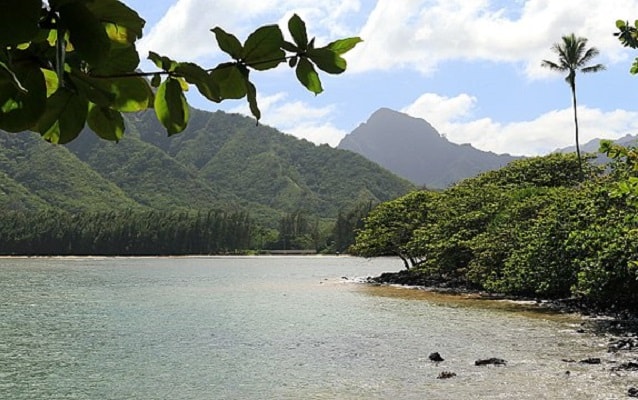Last updated: August 16, 2019
Place
Huilua Fishpond, HI

Photo by Bob Linsdell, CC BY 3.0, https://commons.wikimedia.org/w/index.php?curid=59153123
Huilua Fishpond, in Kahana Bay on the Island of Oahu, illustrates the unique aquafarming practices of the Hawaiian people. Out of the estimated 97 fishponds once on the coast of Oahu, Huilua is one of only six that still exists. The Huilua Fishpond had a 500-foot rock seawall attached to the shoreline that encircled 7 acres of Kahana Bay near the mouth of Kahana Stream. The wall was 3 to 4 feet wide and stood 4 feet above high tide, with two gates that allowed smaller fish in and out of the pond, but kept bigger fish from escaping. Hawaiians were the only ancient Polynesian people to progress from tide-dependent fish trapping to controlled artificial fishponds, making their aquafarming the most advanced among the original peoples of the Pacific.
While the exact date of the Huilua Fishpond's construction is unknown, Hawaiians typically built many of their ponds between the years 1200 and 1600. Early Hawaiians carried rocks from nearby streambeds and valleys to line the shoreline in order to control water levels and prevent sand and sediment from entering the fishpond. Huilua Fishpond's rock seawall encircled seven acres of Kahana Bay's ocean saltwater. At two points along the seawall, mäkähäs(sluice gates) were installed to control the flow of water. The gates connected the saltwater fishpond with the nearby freshwater Kahana Stream to allow the waters to mix and create a brackish environment suitable for raising fingerlings and mullets, two species of fish that migrate between fresh and salt water.
The mäkähä consisted of lashed poles with gaps in-between that allowed water and small mullets from the stream to enter the fishpond. Fingerlings were raised in smaller pua ponds before being released into the larger fishpond. The larger pond was primarily a feeding area in which algae was cultivated. Once the fish entered the pond, they would feed and grow too large to swim back through the small gaps of the mäkähä. The large fish would gather near the mäkähä, allowing the Hawaiians to easily catch and harvest them by hand or with nets.
A photograph of Huilua Fishpond taken in 1910 shows two separate structures near the fishpond, both of which are no longer standing. More than likely, these structures served as a shelter for the kia'i loko, or pond keeper. The kia'i loko, who lived nearby, oversaw the cleaning and repair of the fishpond as well as the stocking and harvesting of the fish. Residents in the surrounding Kahana area assisted the kia'i loko with the care of the pond in return for harvested fish.
A great deal of religious significance was attached to Huilua and other fishponds, which played an important role in Hawaiian culture. The people built stone shrines known as ko'a near the ponds, performed various rituals, and placed offerings in order to attract fish and to ensure their procreation. They also believed that mo'o, large, lizard-like water spirits, inhabited and protected the fishponds. The mo'o of Huilua Fishpond lived in the northwest corner and protected the pond from ritual and environmental pollution. Ritual pollution consisted of any violation of kapu (religious, political, and social laws). For example, if a poacher stole a fish from the waters of the fishpond, the Hawaiians believed that the mo'o would ward off any evil resulting from the sacrilegious act. Legend said that whenever dried leaves floated on the top of the fishpond, the mo'o was present.
While the location of Huilua Fishpond in Kahana Bay helped protect it from large waves and harsh currents, it could not withstand the severe flooding and damage caused by recurring tsunamis (tidal waves). Several powerful tsunamis in the 20th century damaged the Huilua Fishpond walls, filling the pond with large amounts of sand and silt. The worst tsunami hit the island in 1946, breaking the fishpond's stone seawall and filling it with sand and debris. Fortunately the Huilua Fishpond hosted a kia'i loko who oversaw repairs and maintenance of the site and supervised workers as they made rebuilt portions of the seawall. Mortar was added to keep the seawall from deteriorating and several features such as metal grates, cement linings to the sluices, and an additional mäkähä gate were included to stabilize the fishpond. Following these extensive repairs, the fishpond suffered permanent damage from another tsunami in 1960 and fell out of use. Lack of upkeep and repairs quickly led to a decline in the fishpond's water quality and structural integrity. Sand began to fill the pond and mangrove trees, hau bushes, and bulrushes began to grow in the brackish waters.
The Hawaii Division of State Parks began restoration of the fishpond and the seawall in 1993 using archeological surveys and mapping. Today, the Friends of Kahana, an organization of Kahana residents, maintains the Huilua Fishpond and has taken the lead on the fishpond restoration project.
The Huilua Fishpond serves as an ongoing tribute to the technological innovation of the early Hawaiians, who were the first people to develop true aquafarming in the Pacific. Fishponds helped the Hawaiians establish a sustainable food source, which in turn helped them prosper and thrive in their environment.
Huilua Fishpond is a National Historic Landmark. It is located in Ahupua'a 'O Kahana State Park on the island of Oahu. The fishpond is on on the east side of Kahana Bay next to Kahana Bay Beach Park, on the Kamehameha Highway (Highway 83) just outside of the town of Ka'a'awa, HI.
